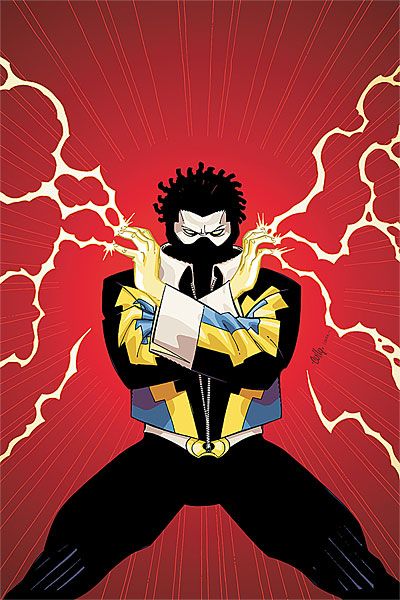In Tony Isabella's original "Black Lightning" series, Jefferson Piece was a high school teacher with a belt which granted him electrical powers. He patrolled Suicide Slum and kept it safe from people like Tobias Whale, a morbidly obese albino Kingpin-type of character.
Apparently DC editorial and/or Jen Van Meter didn't think that was an interesting enough origin story to explore again, so this "Black Lightning: Year One" series reboots the character's origin. I'm sure I've said this before in another review of a "Year One" story from DC, but the problem with these types of stories -- especially ones using that heading -- is that they'll be compared to Frank Miller and David Mazzucchelli's work on "Batman: Year One." None of them have ever come close to the poetically blunt reinvention of a character's origin that Miller and Mazzucchelli pulled off all those years ago, and so these other "Year One" tales immediately feel second rate. And when a creative team comes in and changes the details of a character's origin without any real gain, then it just makes the whole project seem ill-designed. Jefferson Pierce is now a principal, and Tobias Whale is a politician, and Black Lightning's powers seem to be genetic, rather than artificially induced. Perhaps that fits the status quo of the new DCU a bit better than the old origin, but the changes seem to fundamentally alter the kind of character Black Lightning is (akin to changing Peter Parker from a teenage nerd into a jock), and I don't see much point in doing that.
Now "Black Lightning: Year One" #1 isn't a bad comic at all. It has a lot going for it, primarily the visual look created by artist Cully Hamner. Hamner's most recent high-profile work (if you could call it that) was launching the Jaime Reyes "Blue Beetle" comic, and in this comic he's dealing with similar themes, even if the characters and setting look quite different. But like "Blue Beetle," "Black Lightning: Year One" is about family and community, and it deals with class struggles in a way that many comics don't.
Scripter Jen Van Meter writes effective dialogue, whether it's the rhetoric of Pierce-the-principal trying to motivate adolescents, or whether it's the awkward conversations between somewhat estranged siblings. There's nothing particularly interesting or original about any of the dialogue in the comic, but it doesn't detract from the relatively swift-moving story.
But there's just not much here. It's Jefferson Pierce, ex-Olympic athlete turned principal, coming in to a gang-infested area with intentions of cleaning it up. Reading the issue doesn't give you much more texture than you would have gotten reading a summary of it. It all seems so rote, like a by-the-numbers remake of that ghetto drama that you've seen a million times before.
Pierce does have a kind of righteous indignation that might make future issues a bit more interesting, as he turns from being a leader to being a vigilante when his leadership fails to solve the problems. Perhaps Van Meter and Hamner can develop this into a more layered origin story that the first issue indicates. There are still five issues left in the series, plenty of time to make this story into something that matters.

